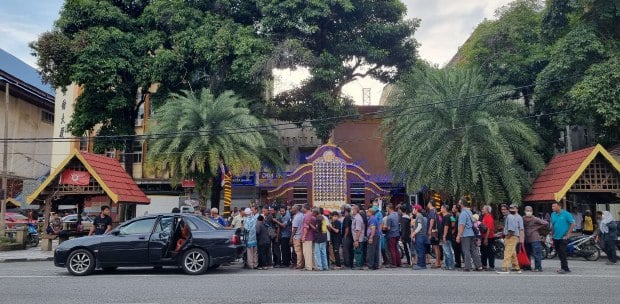ONCE you have learnt how to cycle as a child, you can cycle again at any age, anywhere. Wrong! I found out in the most unexpected way.
The year was 2013. I was all set for a cycling tour of Kota Baru, the Kelantan capital. My cycling gear included a thermal T-shirt, helmet and gloves, all supplied by Kota Baru-based tour operator and ticketing agency H & H Tours.
The company’s co-owner Shamsul Hafiz Mohamed had even chosen a suitable lightweight bicycle for me and adjusted its seat to suit my height. Everything was set. Ten other persons in the cycling tour group were also all suited up, ready to go.
Hafiz’s assistants had lined up all our bicycles outside the office of H & H at busy Jalan Tok Hakim in the centre of Kota Baru. Bikers, cyclists, trishaw riders and pedestrians weaved in and out of the heavy traffic along the two-lane road. Two of Hafiz’s staff helped to marshal the group, making sure the road was clear for everybody to move in a convoy.
Everyone mounted their bicycle and pedalled slowly away, except me. I struggled to balance myself. I couldn’t lift both legs onto the pedals. Seeing this, Hafiz beckoned to his assistant to take me to a side road, and let me practise a while. Hafiz cycled to the rest and asked them to stop and wait.
Even when I managed to have both legs on the pedals, I could only make about three to four wobbly cycles before the bicycle started to sway leftwards towards the drain.
Oh my, this was not good at all. The last time I cycled was about 38 years ago when I was a college student. How wrong I was when I agreed to do the cycling tour, thinking that cycling again after all this while would still be a piece of cake.
The thing was, as I grew older, I developed tinnitus, with a perpetual ringing in my left ear. This affected my sense of balance. Even mounting the bicycle that day, I felt giddy. I explained my condition to Hafiz, and without hesitation, he asked me to board the van and join his marshals. And so my quest to cycle again ended that day.
I looked forlornly at the cycling group, out of which three were senior citizens, pedalling steadily along the roads of Kota Baru. The cycling tour, led by Hafiz, covered 30km, spanning the capital city’s historical and cultural route, and the icing on the cake — Kelantan’s gastronomic adventure.
GLIMPSES OF CULTURE & HISTORY
Leaving Jalan Tok Hakim behind, we went towards the historical and cultural heart of Kota Baru at Jalan Hilir Kota and Jalan Sultan, passing through the Sultan Ismail Petra Arch that marked the entrance to Kota Budaya (cultural city).
Clustered around the area were several museums, memorials and palaces, including Istana Batu (Royal Museum — rich repository for the history of Kelantan royal family), Istana Jahar (featuring Kelantanse cultural heritage), Bank Pitis (Money Museum) and Bank Kerapu (World War II Memorial).
It was at Bank Kerapu that we stopped the longest. The military paraphernalia of the Japanese Occupation from 1941 to 1945, as well as old pictures and documents of that period were intriguing stuff that showed the atrocities committed against mankind.
We left the gruesome displays and headed for the lookout tower Menara Jam Tambatan DiRaja at the Sungai Kelantan riverbank.
Stopping there was a respite from the late morning heat, as we enjoyed the gentle breeze and the panoramic view of the town and the long, bulging river. And it did all feel casual and happy in the sunshine. Rafthouses cast reflections on the murky water. Fishing trawlers, sampans and water taxis glided on the river that has long been the lifeline of the locals as their transportation passage and water source for a lot of uses.
Next, our cycling group pedalled to a traditional match factory, the Kelantan Match Factory Sdn Bhd, which has been producing matches since more than 80 years ago. The thousands of tiny matches looked like a band of marching army in the production line.
The nearby Kraftangan Village was the stopover for lunch and a spate of shopping for Kelantan souvenirs. The village is the hub of local arts and crafts, including Kelantan batik, woodcraft and silverware. A craft museum stands within a beautiful courtyard. Lunch was a hearty kampung fare at the hugely popular Nasi Ulam Cikgu located in the village. Then a short stop for prayers at Masjid Muhammadi, the State Mosque.
TRADITIONAL CRAFTS
The roads in Kota Baru were fairly smooth with little bone-shaking bumps. Though we moved slowly, other traffic often gave way to our convoy, making the cycling tour pleasant and safe. Hafiz and team knew exactly what to do, stopping traffic when necessary, with the least of hindrance to other road users.
Hafiz revealed that he loved cycling and it has helped him to reduce by nearly half his initial weight of 216kg.
“Cycling is also good for my health,” added Hafiz who loves travelling, a fact that pushed him to open up his own travel-based company. He pioneered the cycling tour of Kota Baru, offering standard and customised cycling packages of varying stops, distances, and rates, which start from RM120 per person, for a minimum of two persons.
It was quite a long cycling stretch in the afternoon, which was good to burn off the heavy lunch. The next stops were Cik Minah Songket where we saw how the intricate songket fabrics with woven gold and silver threads were made.
Over at Kartika Kiara Batik, young girls and men had us enthralled by the ease with which they created batik designs from start to finish.
Even more fascinating was the traditional and manual work taking place at a kite-making workshop, a rickety wooden house standing on the side of the road leading to Pantai Cahaya Bulan (Moon Light Beach).
There we met Shafie Jusoh, 66, the remaining few who made kites, including the Kelantanese giant kites, the wau bulan. At a height of two metres at least, the wau bulan are higher than the men who fly them.
We saw Shafie nimbly shaved pieces of bamboo, one of the items required to make the kite. Using rice paste, he attached coloured paper with varying designs from floral to animal shapes, to the bamboo frame. If a piece of bamboo has been shaved too thin, the kite cannot be launched. Though everything was done manually, the kite’s weight and balance was so carefully calculated to enable it to fly. It took experience like that of Shafie’s to do this.
The road to Pantai Cahaya Bulan meandered past sleepy fishing villages with wooden cottages, coconut groves and burbling streams. The beach with fine powdery sand straddled the shoreline of the South China Sea.
Hafiz led us to a spot near the beach at Pulau Kundor where a World War II bunker stood like a sore thumb. It was a grim reminder of the fact that the Japanese invasion of Malaya started from Kelantan when the Japanese troops landed on Pantai Sabak on Dec 8, 1941.
From Pulau Kundor, we headed for Pulau Pisang for an afternoon treat of spicy fish head soup and teh tarik madu (pulled tea with honey) at the famous restaurant called Warung Pak Mat Pulau Pisang. Then we walked to the nearby jetty for a boat transfer, leaving our group’s bicycles behind for later pickup by Hafiz’s team.
WAYANG KULIT & SERUNDING
During the half-hour boat ride along Sungai Kelantan, it was obvious that some of the older cyclists were dead tired. One developed leg cramps. Thank god the cycling was over. But the tour hadn’t ended. After landing at Kampung Laut jetty, we walked to Kampung Laut to the house of Yusof Mamat, the rare maker of patung wayang kulit (shadow puppets).
Shadow play is a dying culture, which is a pity, but it’s people like Yusof who keep it alive. We saw how he intricately carved pieces of leather and turned them into puppets.
Then he treated us to a solo puppet theatre performance. He took his seat behind an illuminated screen to assume the role of the Tok Dalang (puppet master). It was sheer joy to see him manipulate the puppets, and narrated a story using different voices for different puppets.
What was missing was the traditional folk musical ensemble but Yusof’s solo performance was worthy of our loud applause.
Kampung Laut to me was one large kitchen. For years, the village women have been cooking serunding (chicken, beef or fish floss) and many kinds of cakes and pastries. They bring their produce to the markets in Kota Baru by boat. We visited the home of Che Yah Che Well, 60, who made serunding in many huge brass pots to meet demand for her spicy serunding, famous even outside Kelantan.
The tour later ended with a scrumptious dinner of nasi kerabu and ayam percik, a Kelantanese staple, at Yati Ayam Percik in Kota Baru.
It was gratifying for me to see that the culture and traditional lifestyle of Kelantan are alive and well.
Though the world elsewhere is moving rapidly, Kelantan will keep pace in its own sweet time. Meanwhile, I harboured the desire to learn how to cycle all over again, and do it at my own pace.
TRAVEL FILE
Gastronomic adventure
THE H & H cycling tours of Kota Baru also include several great stops for Kelantanese food. The tours highlight flavours of Kelantan and places highly popular with locals.

KOPITIAM KITA, TAMAN DESA JASA
This is the must-go kopitiam for some of the best breakfasts and brunch in town, available from 8am to 1.30pm. Try its roti titap, which is perfect half-boiled egg on bread toasted over charcoal fire, and comes with dollops of kaya. A great place also to sample pre-packed Kelantanese rice-based dishes, such as nasi berlauk and nasi tumpat.

NASI ULAM CIKGU, KRAFTANGAN VILLAGE
Trays of ulam (fresh kampung salad), bowls of sambal and budu (fermented anchovies), best taken with a squeeze of lime and cili padi. The budu is perfect with hot rice and grilled fish. The kampung spread is so wide here that you’d be hard-pressed to choose.

WARUNG PAK MAT, PULAU PISANG
Its specialties are fish head soup and teh tarik madu (pulled tea with honey). The soup is spicy, the fish head fresh. Slices of cili padi swim in the soup so be prepared for your tongue to be torpedoed! Douse the heat afterwards with the super sweet teh tarik madu, a messy concoction of milk tea with hot honey. It’s like drinking, rather, slurping, a volcanic lava of liquid.

YATI AYAM PERCIK, JALAN LONG YUNUS
The must-try are nasi kerabu (rice with fresh sliced kampung salad and sweet, spicy condiments) and ayam percik, which is grilled chicken marinated in spices, lemon grass, tamarind and coconut milk. The chicken is aromatic and succulent.

MAGGI KETAM INDRA TOMYAM, KAMPUNG PASIR PEKAN
Fresh crabs and prawns come in spicy sweet broth and instant noodles, all served in earthen bowls. You’ll lick your fingers when you are done.
For details of H & H cycling tours, call 09-741 2000 or email [email protected]
TELL
For Putri Zanina, travelling is her tonic to a rich, fulfilling life. It also turns her into a storyteller. Reach her at [email protected]









